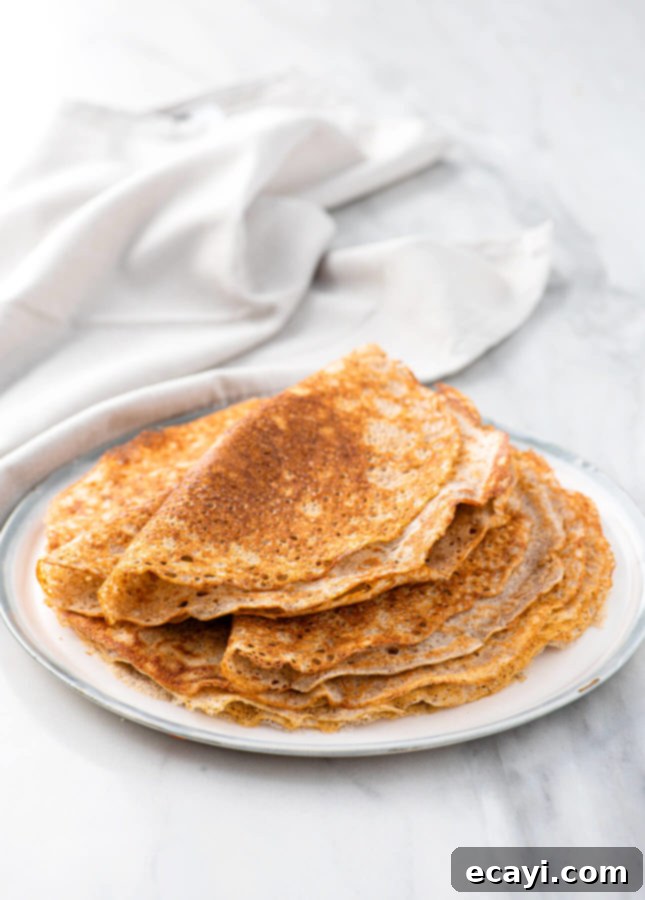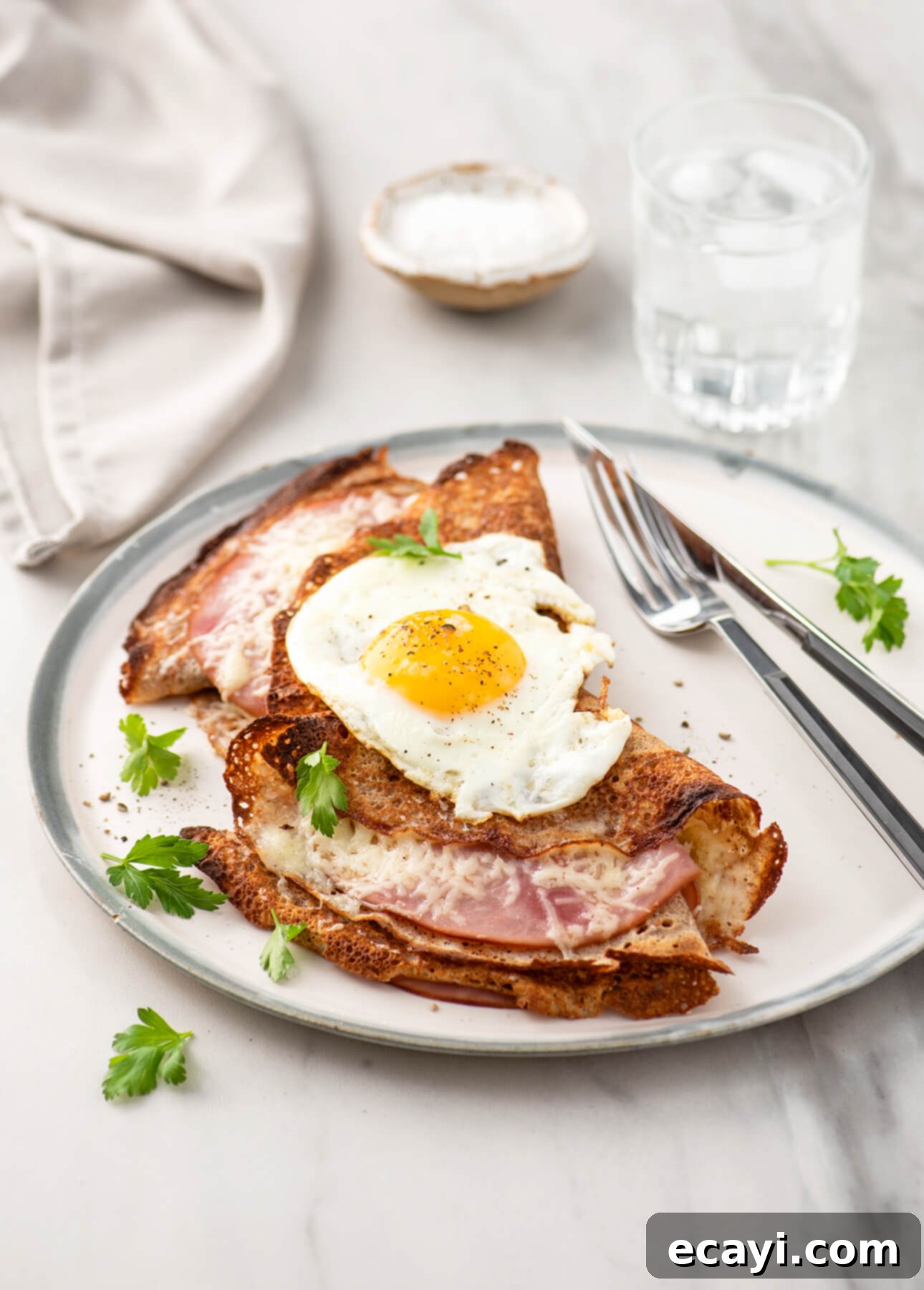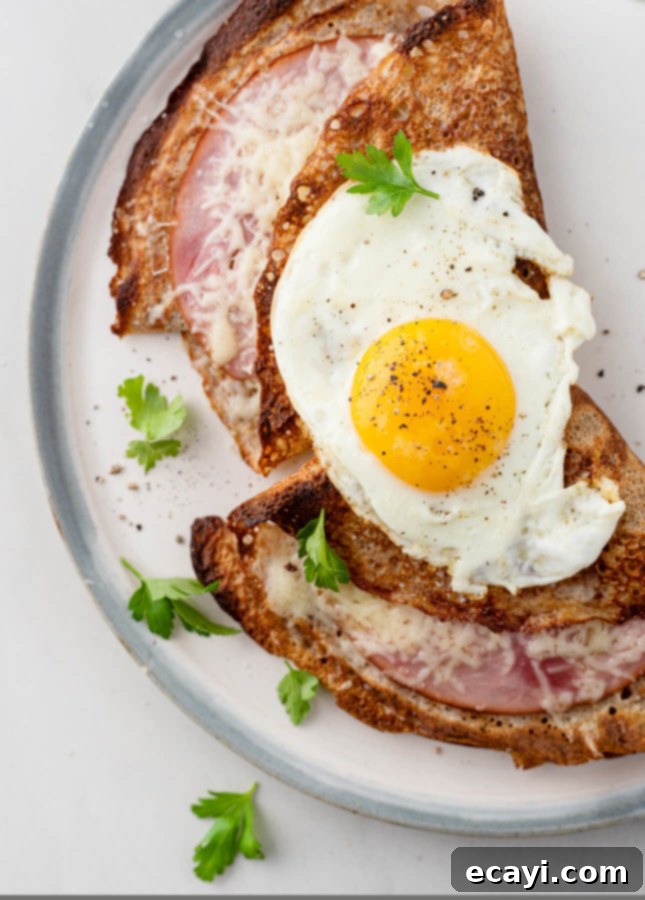Mastering Galettes Complètes: The Ultimate Savory Buckwheat Crepes with Ham, Cheese, and Egg
These savory buckwheat crepes, known in France as Galettes Complètes, are generously filled with savory ham and gooey cheese, then crowned with a perfectly fried egg. This creates an incredibly delicious and wonderfully nutritious dish, ideal for a special breakfast or a hearty brunch.

This post contains affiliate links. Full disclosure is at the bottom of the article.
The World of French Cuisine: A Journey to the Heart of Crêpes
Some culinary delights instantly reveal their French heritage with just a mention of their name. Think of the classic quiche Lorraine, the delicate madeleine, or the vibrant macaron – each a delicious articulation of France’s rich gastronomic legacy. Yet, one particular dish has seamlessly integrated into the global culinary lexicon, especially beloved by breakfast and brunch enthusiasts worldwide: the humble yet elegant crêpe.
These large, wonderfully thin French pancakes have long held their esteemed position as one of the most celebrated French dishes internationally, and their widespread appeal is easy to comprehend:
- Unmatched Versatility: Crêpes are a blank canvas for culinary creativity. They can be prepared in countless ways, adapting effortlessly to sweet or savory profiles. Enjoy them as a light breakfast, a satisfying lunch, an elegant dinner, or a delightful dessert. From fruit and chocolate to cheese, meat, and vegetables, the filling possibilities are virtually endless, making crêpes suitable for any meal or occasion.
- Effortless Make-Ahead Convenience: Crêpes are a dream for meal preppers and busy home cooks. The batter can be whisked together days in advance and stored in the refrigerator, allowing you to cook fresh crêpes on demand. Alternatively, you can prepare a large batch of crêpes all at once, then freeze them for several months, ensuring a quick and delicious meal is always within reach. This flexibility makes them perfect for entertaining or simplifying weeknight dinners.
- Surprisingly Simple to Master: While your initial attempts might not yield perfectly circular crêpes, a little practice goes a long way. With proper pan preparation (lightly oiled or buttered) and a steady hand, you’ll quickly achieve the signature crêpe texture: tender in the center with delightfully crisp, golden-brown edges. Don’t be discouraged by early imperfections; the journey to perfect crêpes is a rewarding one. For expert guidance, be sure to consult my detailed “Helpful Tips” section below to ensure your success from the very first crêpe.
Crêpes, in their broadest definition, encompass a wide array of preparations. However, today, we delve into a cherished classic from the northern regions of France, specifically the picturesque region of Brittany: savory buckwheat galettes. To merely state that buckwheat galettes are popular in Brittany would be an understatement; they are an intrinsic part of the region’s cultural fabric and daily life. It is, without a doubt, one of the aspects I adore most about Brittany. Each time I visit, I find myself indulging in buckwheat galettes, often paired with a local cider, for lunch nearly every day!
Exploring the Galette Tradition of Brittany: Sweet vs. Savory
In Brittany, the culinary landscape celebrates crêpes with entire restaurant menus dedicated to these thin pancakes. Here, a crucial distinction is made: sweet crêpes are typically made with wheat (all-purpose) flour and are often smaller, served with sweet fillings like sugar, jam, or chocolate. In contrast, savory crêpes are known as galettes. These galettes are traditionally crafted from dark, earthy buckwheat flour, boasting a significantly larger diameter, and are generously filled with a diverse range of savory ingredients, including various meats, eggs, an assortment of cheeses, and fresh vegetables. This distinction is not just semantic; it reflects a deep-rooted culinary tradition and a difference in flavor and texture profiles.

Among the myriad of Breton galettes, the undisputed queen is the galette complète. This iconic dish features a buckwheat pancake generously filled with savory ham and rich, melting cheese, then expertly topped with a fried egg. This particular rendition is my absolute favorite way to enjoy buckwheat crêpes, primarily because it lives up to its name – it truly is “complete” in every sense. The harmonious blend of gooey, savory cheese, perfectly cured ham, and a luscious, often runny, fried egg, all encased within a crisp-edged, flavorful crêpe, creates an unparalleled taste experience. It’s surprisingly simple to prepare (especially when the crêpes are made in advance!) and offers substantial nutritional value, yet it feels like a wonderfully luxurious meal. For an authentic Breton experience, serve your galette complète with a glass of crisp, sparkling cider.
How to Make the Perfect Savory Buckwheat Crêpes (Galettes)
Achieving consistently perfect savory buckwheat crêpes requires attention to a few key techniques. Follow these expert tips for making delicious, authentic galettes every time:
- Prepare the Crêpe Batter in Advance: This step is not merely for convenience; it’s a crucial technique for achieving superior crêpes. Allowing the crêpe batter to rest in the refrigerator for at least 2 hours, or ideally overnight (up to 24 hours), gives the flour time to fully hydrate. This hydration allows the gluten in any wheat flour present to relax (or in the case of pure buckwheat, for the starch particles to fully absorb liquid), resulting in a more pliable, smoother batter that yields more flexible, lighter crêpes that are less prone to tearing. You can blend or whisk the batter together in just a few minutes, making it an easy task to complete the day before.
- Ensure Your Batter Achieves the Ideal Consistency: The perfect savory buckwheat crêpe batter should be notably loose and flowing, allowing it to effortlessly spread across the surface of the pan. This fluidity is essential for creating the characteristic thinness of traditional crêpes. Aim for a consistency similar to that of heavy cream – thick enough to coat a spoon, but thin enough to pour and swirl easily. Given that flour textures can vary significantly, especially with buckwheat flour which can sometimes be quite coarse, you may need to adjust the batter by adding a small amount of milk (or water) to achieve the perfect pourable consistency. If it’s too thick, your crêpes will be heavy; too thin, and they’ll be hard to manage.
- Choose the Right Pan – Especially if You’re New to Crêpe Making: While seasoned crêpe aficionados often swear by traditional steel or heavy cast-iron pans for their superior heat retention and non-stick properties once seasoned, these can be challenging for beginners. Cast-iron pans, for example, are quite heavy, which can make the crucial swirling motion to spread the batter difficult. The classic râteau à crêpes, a specialized wooden T-shaped tool used by experts to evenly spread crêpe batter, also requires considerable practice to master. However, rest assured that no specialized or expensive equipment is necessary to produce exquisite crêpes at home. A simple 10 to 12-inch (25-30 cm) nonstick pan works wonderfully. Nonstick pans inherently prevent sticking, minimizing waste and frustration for novice crêpe makers, allowing you to focus on the technique rather than battling a stubborn crêpe.
- Preheat Your Pan Thoroughly on Medium Heat: Patience is key here. Before you add any batter, allow your pan to preheat for several minutes over medium heat. The goal is to achieve a consistent, moderate temperature across the entire cooking surface. An evenly heated pan is fundamental for proper crêpe cooking, ensuring uniform browning and preventing raw or burnt spots. If the pan isn’t hot enough, the crêpe will be pale and won’t crisp; if it’s too hot, it will burn before it cooks through.
- Generously Grease Your Pan, Even if it’s Nonstick: While nonstick pans help prevent sticking, a generous application of oil or butter is still vital. Greasing the pan not only makes it easier to flip the crêpes but also contributes significantly to their desirable crispness and golden-brown color. You should apply a generous amount of cooking fat (butter or a neutral oil like canola or grapeseed) before cooking your very first crêpe. After every three or four crêpes, replenish the fat with a little more oil or butter to maintain optimal cooking conditions. This ensures consistent quality throughout your batch.
- Pour and Swirl the Crêpe Batter with Speed and Precision: Once your pan is perfectly heated and greased, pour the measured amount of crêpe batter (typically 1/3 cup or 80 ml for an 8-inch crêpe) into the center of the pan. Immediately and quickly, lift the pan and gently swirl it in a circular motion to spread the batter evenly across the entire surface. This rapid motion is critical to create a thin, uniform crêpe. If the pan is excessively hot, the batter will “seize” or cook too quickly upon contact, preventing you from spreading it properly and resulting in a thick, uneven crêpe. Adjust your heat if this occurs.
- Master the Art of Flipping: A crêpe will communicate when it’s ready to be flipped through several visual cues. Its edges will begin to curl away from the pan, and you’ll notice small bubbles forming across the surface of the crêpe, which will also appear dry. A properly cooked crêpe will release easily from the pan – if it sticks, it means it’s not quite ready; give it a few more seconds. The second side of the crêpe cooks much faster than the first, typically requiring only about 1 minute until it’s beautifully golden brown and lightly crisp.
- Stack and Store Your Cooked Crêpes: As each crêpe finishes cooking, stack them directly onto a large plate kept warm near your stove. This helps keep them pliable. Once all your crêpes are cooked, you have options for storage. They can be used immediately, or allowed to cool completely, then covered tightly with plastic wrap and refrigerated for up to five days. For longer storage, crêpes freeze exceptionally well. To freeze, stack them in portions you plan to use, carefully wrapping each flat stack in plastic wrap (you can place parchment paper between each crêpe for extra protection, though not strictly necessary if wrapped flat). Transfer the wrapped stacks to a baking sheet and freeze until solid. Once frozen hard, you can transfer them to a heavy-duty freezer bag or a large airtight container for up to a month or more. It’s essential to freeze buckwheat crêpes flat; in my experience, they can become brittle and prone to breaking if thawed while folded. Save the folding step for assembly just before serving to maximize your chances of keeping your carefully crafted crêpes in one piece.
- Assemble Your Crêpes Traditionally – or Simplify for Stress-Free Serving: Traditionally, Breton galettes are laid flat, garnished with cheese and ham, then the edges are folded in by an inch or two to create a square shape. An egg is then cracked directly over the center. The residual heat from the galette is meant to gently cook the egg, leaving the yolk wonderfully runny. In Brittany, some prefer the egg white barely set, while others finish the galette in the oven to fully cook the egg. This traditional method, while charming, can be stressful and tricky for home cooks, especially when preparing several galettes for a family meal or guests.
Here’s a streamlined, stress-free method to assemble and serve perfect galettes complètes: Begin by garnishing your pre-cooked crêpes with the desired amount of cheese and ham. Fold each crêpe into quarters, creating a neat, triangular shape. Transfer these folded crêpes to a baking sheet lined with parchment paper. Place the baking sheet in a preheated 325°F (160°C) oven for 5 to 10 minutes. This gentle heat will effectively melt the cheese and re-crisp the crêpes to perfection. While the crêpes are warming, heat a generous knob of butter or oil in a large skillet over high heat and fry your eggs sunny side up to your preferred doneness. (If the crêpes are ready before the eggs, simply remove the baking sheet from the oven and let them rest while you finish cooking the eggs.) For each serving, arrange two folded crêpes on a plate and crown them with one freshly fried egg. This simplified approach delivers all the deliciousness and visual appeal of the traditional method, ensures your eggs are perfectly cooked to your liking, and makes it incredibly easy to produce multiple servings quickly and without any fuss.
Navigating Gluten-Free Savory Buckwheat Crêpes
Buckwheat flour is naturally gluten-free, and authentic traditional Breton galettes are, in fact, made exclusively with 100% buckwheat flour. However, the inherent absence of gluten in a purely buckwheat batter means it lacks the elastic structure that gluten provides. This often results in crêpes that are more delicate, fragile, and prone to tearing or breaking, especially for those new to working with buckwheat. This is precisely why many modern recipes for galettes frequently recommend replacing about one-third of the buckwheat flour with wheat (all-purpose) flour. Crêpes made with this blend are generally more supple, easier to handle, and less likely to break during cooking or folding.
Nevertheless, if you choose – or need – to prepare your savory buckwheat crêpes entirely gluten-free, you have excellent options. You can certainly use only 100% buckwheat flour. When doing so, be mindful of the batter’s delicate nature and handle the crêpes with extra care during cooking and flipping. Alternatively, you can substitute the all-purpose flour in the recipe with a high-quality gluten-free all-purpose flour mix. These specialized blends are formulated with various starches and gums (like xanthan gum or guar gum) that effectively mimic the elasticity and binding properties of gluten. Using such a mix should yield crêpes that are both supple and resilient enough to handle folding and filling without crumbling, offering a delightful gluten-free experience without compromising on texture or taste. Experiment to find the method that best suits your dietary needs and desired texture.


Pin Recipe
Savory Buckwheat Crepes with Egg, Ham, and Cheese (Galettes Complètes)
Ingredients
- For the Savory Buckwheat Crêpes:
- 1/2 cup (60 g) buckwheat flour
- 1/4 cup (31 g) all-purpose flour
- 1/4 tsp (1 ml) kosher salt, or fine sea salt
- 1 1/4 cups (310 ml) milk, preferably whole (3.25 % m.f.)
- 1 large egg
- To Serve:
- 1 1/2 cups (6 oz / 170 g) coarsely grated Gruyère cheese, or substitute Swiss, Emmenthal, or Aged Cheddar cheeses
- 6 large, thin slices of smoked ham
- 4 large eggs
- Oil for frying (or butter)
- Flaky sea salt and freshly ground black pepper to taste
- Minced chives optional, for garnish
Instructions
-
To prepare the savory buckwheat crêpe batter: In a large mixing bowl, combine the buckwheat flour, all-purpose flour, and salt. Add the milk and the egg, then whisk vigorously until the batter is completely smooth and free of lumps. Cover the bowl and refrigerate the batter for a minimum of 2 hours, or for best results, allow it to rest overnight.
-
To cook the savory buckwheat crêpes, place a crêpe pan or a non-stick skillet over medium-high heat. Lightly spray the pan with cooking oil or use a piece of paper towel to evenly rub a small amount of butter onto the pan’s surface. Pour approximately 1/3 cup (80 ml) of the chilled buckwheat crêpe batter into the pan. Immediately and quickly swirl the pan to spread the batter thinly and evenly over the entire surface, forming an 8-inch (20 cm) crêpe. Allow the crêpe to cook and brown on one side until the edges appear crisp and pull away from the pan, which usually takes about 1 minute. Flip the crêpe over and cook for an additional minute on the second side until it’s golden brown.
-
Carefully transfer the cooked crêpe to a large plate. Continue this process, cooking the remaining crêpes and stacking them on top of each other as they are finished. At this stage, the cooked crêpes can be covered and refrigerated for up to 3 days, or they can be frozen in an airtight container or a heavy-duty freezer bag for up to 1 month. Ensure they are frozen flat to prevent breakage.
-
To assemble and serve the savory buckwheat crêpes (Galettes Complètes): Preheat your oven to 400°F (200°C). Line a baking sheet with parchment paper.
-
Lay one savory buckwheat crêpe flat on a clean working surface. Sprinkle with approximately 1/4 cup (1 oz / 28 g) of the grated cheese, then top with 1 thin slice of smoked ham. Fold the crêpe in half, then fold it in half again to create a quarter-circle shape. Carefully transfer this folded crêpe to the prepared baking sheet. Repeat this process for all the remaining savory buckwheat crêpes. Bake in the preheated oven for 5 to 7 minutes, or until the edges of the crêpes are slightly crispy and the cheese has melted beautifully.
-
While the crêpes are baking, heat oil (or butter) in a large skillet over high heat. Fry the eggs sunny side up to your desired doneness, seasoning each with a pinch of flaky sea salt and freshly ground black pepper as they cook.
-
To serve, place two folded savory buckwheat crêpes per person on a plate. Top each serving with one freshly fried egg. If desired, garnish with a sprinkle of minced chives for a touch of freshness. Serve immediately, perhaps alongside a simple green salad for a complete and delightful meal.
-
Recipe Credit: This recipe has been adapted from a classic by David Tanis, featured in The New York Times.
Did you make this?
Tell me how you liked it! Leave a comment or take a picture and tag it with @foodnouveau on Instagram.
This site is a participant in the Amazon Associates Program, an affiliate advertising program designed to provide a means for the site to earn fees by linking to Amazon and affiliated sites.
If you click on an affiliate link, I may earn advertising or referral fees if you make a purchase through such links, at no extra cost to you. This helps me in creating new content for the blog–so thank you! Learn more about advertising on this site by reading my Disclosure Policy.

